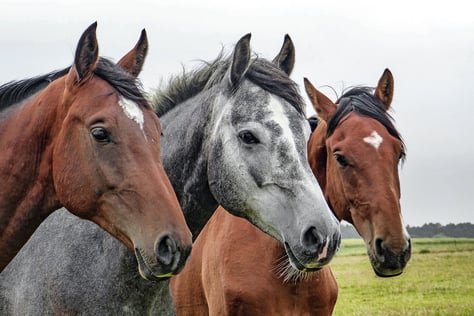In Honor of St. Patrick's Day. - Ireland is a land of incredible beauty and incredible horses. The following three breeds were developed to work with people of Ireland under a variety of tough conditions. Their hardiness and easy temperament are legendary. 
CONNEMARA PONY
Legend says that when the Spanish Armada sank off the Connemara coast in the 16th Century, the horses, a mix of Barbs and Andalusians, swam to shore and bred with the native ponies running wild in the mountains. The resulting Arab blood is still recognizable in present day Connemara's. Steep mountain trails and treacherous bogs, fierce winds sweeping in from the Atlantic in the winter, and relatively small areas of grazing developed a breed that was tough and surefooted. The Connemara became known for their agility and hardiness. The Irish soon came dependent on this stocky little horse as a means of transportation and its ability to pull a plow, cart turf from the bogs or seaweed from the shore and carry heavy baskets of produce to market. On Sunday, the pony carted the family off to church. Because of this strong partnership, the Connemara developed an easy-going and reliable temperament.
The Connemara is the tallest pony breeds ranging in height from 13–15hh.
More information: American Connemara Pony Society
IRISH DRAUGHT
The Irish Draught is sometimes referred to as an RID for Registered Irish Draught. According to the legends, it was the god Lugh who brought the horse to Ireland. He was and Irish god viewed as a hero and High King of Ireland’s distant past. Lugh’s special festival, Lughnasa, was celebrated at harvest time in early August. As a means of reinforcing tribal bonds, Lughnasa was a time for meeting, for settling arguments – and for horseracing. The Irish farmer needed a horse that could do more than just plow the field. Like the Connemara, the Irish Draught can work all week, successfully go fox-hunting on Saturdays, and drive the family in their cart to Church on Sunday. During the Great European Wars, they were used as army artillery horses.
The Irish Draught is an active, powerful horse with substance and quality. Colors include any solid color, including grey. Height is typically 15.3hh to 16.3hh and has an exceptionally strong and sound constitution. They are intelligent with a gentle nature and common sense.
More information: Irish Draught Horse Society of North America
GYPSY VANNER
From about 1885, people traveling in the British Isles (then including all of Ireland) began to use a distinct type of horse to pull their vardos, the caravans in which they had just begun to live and travel. The Gypsy Vanner was bred by the Roma (also called Romani or Romany), a traditionally nomadic ethnic group. The Roma are widely known as “Gypsies”. They used colored horses, included a significant number of colored Shire horses, which had become unfashionable in mainstream society and were typically culled. Among these were a significant number of colored Shire horses. The term “vanner” dates to at least 1888 and referred to a type of horse rather than to a distinct breed. A “vanner” is “a light horse suitable for drawing a small van.
The first glance, impression of the breed is its stature as a small draft horse with feathering, muscular development and size. The height is usually between 13.2hh to 15.2hh. One of the unique characteristics of the breed is the excessive feathering on the rear of the fore and hind legs, starting from the knee and hock and extending down and over the hooves. The leg feathering provides natural protection to the legs from the weather and working conditions. The Gypsy Vanner is not a breed based on color, although the easily recognizable coat colors set the breed apart from others. The acceptable descriptive terms for the coat colors of the Gypsy Vanner horse are:
Piebald – Black and white Tobiano
Skewbald – Combinations of brown, red and white, including tri-colored Tobiano
Blagdon – Solid color with white splashed up from underneath.
The breed temperament should be gentle, cooperative and willing, yet powerful. The breed should be relaxed, mannerly, and respectful of its environment. Their willingness should be expressed in their ability of being both ridden and driven.
More information: Gypsy Vanner Horse Society



